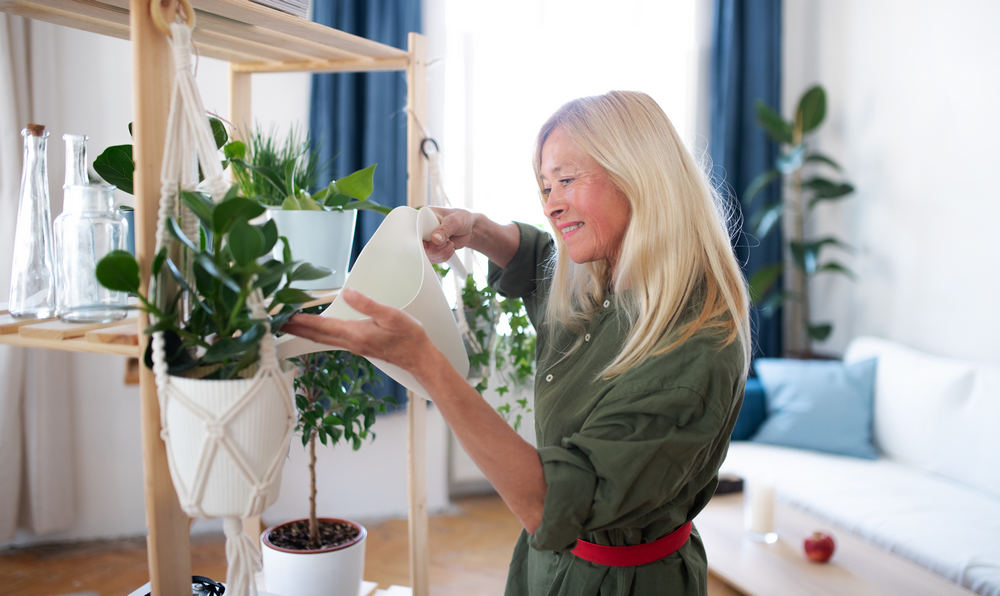Are you finding yourself outside more, distracted by sunny days and gentle breezes? Are you outdoors admiring your perennial blooms and bountiful vegetable garden? Now that it’s summertime, you may find yourself outside more often, ignoring your indoor chores. One chore you absolutely shouldn’t ignore, though, is caring for your houseplants! Indoor plants beautify your home every season, and although they don’t ask for too much, they tend to crave attention, especially in the summer. Show them some much-deserved love and affection with these simple summer plant care tips and tricks for houseplants:
Check Sun Exposure
Plants can’t put on sunscreen, so they rely on you to protect them from the hot summer sun. Summer brings longer days and more intense sunlight, so you may have to rearrange and relocate your indoor plants. Watch where the light falls in the spaces you keep your plants and adjust them accordingly. With the seasons changing, you may find that a once-protected windowsill is now overwhelmingly sunny and hot, and a once-bright space now gets more shade than sun.
The amount of sunlight your plants receive can let you know if your plants are unhappy. Too much sun can cause scorched leaves and limp foliage. Too little sun causes slow growth, leggy stems, and pale, smaller, dropped, or dead leaves. Changing the location of your plants if they look dreary or dried out can help bring them back to their beautiful and lively state.
Keep an Eye on Temperature and Humidity
A consistent room temperature of 70-80˚F with some humidity in the air is ideal for most houseplants. Houseplants like it better when the conditions around them stay the same. You can increase indoor humidity by clustering plants together, placing a humidifier in the room where your plants are kept, or frequently misting the air around them with water from a spray bottle.
Houseplants aren’t the biggest fans of cool breezes. Fans, air conditioners, and open windows can change a room’s temperature and dry out the air, which steals moisture from your plants’ soil and damages their delicate foliage. Avoid placing plants directly in front of a blowing fan, air conditioner, open window, or door – not only will they not like the cold air, but a sudden gust could even topple them to the floor!
Water Whenever the Soil is Dry
Houseplants typically aren’t that demanding, so it may surprise you when they start asking for water more often. Your indoor plants will need consistent watering in the summer because of the hotter temperatures, increased sunlight, decreased humidity, and rapid growth. Check the soil each day by pressing into the top inch or so with your finger. If it’s dry, it’s time to water. You can then get an idea of when you need to water and set a watering schedule. Use a watering can with a spout to direct moisture to the soil around each plant’s base.
Feed Once a Week
Summer’s warmer air and additional sunlight can cause some indoor plants to grow faster than usual. Growth spurts use up a lot of energy, so your plants will be hungry. You’ll want to replenish the soil with healthy nutrients during weekly feedings when you water or by applying them directly to the soil.
Keep Plants Clean and Pest-free
If you’re opening your windows this summer, remember that they can invite unwanted dust, pollen, and sometimes pests into your home and onto your plants. When dust settles on foliage, it can block the air and sunlight needed to reach the plant for healthy growth. Thankfully, it’s easy to clean dust off your indoor plants. Schedule a weekly “bath time” and use a damp cloth or paper towel to wipe dust from the foliage. A damp sponge works best for plants with shiny, thick leaves. Avoid water on cacti and plants with “fuzzy” leaves; instead, use a soft, dry paintbrush to dust them.
Inspect your houseplants for sneaky pests like gnats, mealybugs, and mites. They may hide in the soil or on the undersides of leaves, cause speckles and pale spots, or leave behind silky or cottony webs. If you notice signs of pest infestation, remove and clean the ailing plant immediately, and keep it separated from the others until you can diagnose and treat the problem.
Repot if Needed
Sometimes your houseplants’ summer growth can lead to outgrowing their containers. If you find yourself watering more often, see roots or water running straight out of a pot’s drainage holes, or notice slowed growth, your plant is trying to tell you that it’s feeling cramped and needs more space. Crowded roots will appreciate the room when you repot them in slightly wider containers. Your healthy and growing houseplants will respond well to repotting in the spring and summer. If a houseplant shows signs of stress or is in bloom, it is best to wait to repot them.
Your indoor spaces can be as green and inviting as your backyard garden with proper summer houseplant care. They will provide a spark of fresh and vibrant life for those days when you’re stuck inside. Give us a call at (858) 488-0611 or click here to explore our entire plant catalog!





